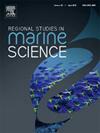Identifying sediment composition and microplastic formation in the production water of flexible pipelines
IF 2.1
4区 环境科学与生态学
Q3 ECOLOGY
引用次数: 0
Abstract
Two distinct kinds of sediments found in the pressure sheath of a decommissioned water injection pipeline were analyzed through Scanning Electron Microscope/Energy-dispersive X-ray spectroscopy (SEM/EDS), X-ray diffraction (XRD), and Attenuated Total Reflectance-Fourier Transformed Infrared (ATR-FTIR) spectroscopy. The analysis showed that as the pipeline sections get farther from the well, the composition of the sediment changes. The red-colored sediments showed much more iron in the form of iron hydroxide, while the grayish sediments showed more calcium in the form of calcium carbonate, and both kinds of samples showed the presence of Polyethylene (PE) polymer. The iron oxide was attributed to the corrosion of the pipeline, which is carried by water during the injection process. The PE in the deposits was attributed to the erosion of the pressure sheath and the use of cleaning agents containing polymers. This indicates that careful measures need to be taken to deal with this potential problem regarding microplastics in the case of a leak or the soil.
柔性管道生产水中沉积物组成及微塑性形成的识别
通过扫描电子显微镜/能谱(SEM/EDS)、x射线衍射(XRD)和衰减全反射-傅里叶变换红外(ATR-FTIR)光谱分析了在退役注水管道压力环中发现的两种不同类型的沉积物。分析表明,随着管道段离油井越远,沉积物的组成也发生了变化。红色沉积物中以氢氧化铁的形式含有较多的铁,而灰色沉积物中以碳酸钙的形式含有较多的钙,两种样品均含有聚乙烯聚合物。氧化铁是由于管道的腐蚀,在注入过程中由水携带。沉积物中的PE是由于压力护套的侵蚀和含有聚合物的清洗剂的使用造成的。这表明,在泄漏或土壤的情况下,需要采取谨慎的措施来处理有关微塑料的潜在问题。
本文章由计算机程序翻译,如有差异,请以英文原文为准。
求助全文
约1分钟内获得全文
求助全文
来源期刊

Regional Studies in Marine Science
Agricultural and Biological Sciences-Ecology, Evolution, Behavior and Systematics
CiteScore
3.90
自引率
4.80%
发文量
336
审稿时长
69 days
期刊介绍:
REGIONAL STUDIES IN MARINE SCIENCE will publish scientifically sound papers on regional aspects of maritime and marine resources in estuaries, coastal zones, continental shelf, the seas and oceans.
 求助内容:
求助内容: 应助结果提醒方式:
应助结果提醒方式:


